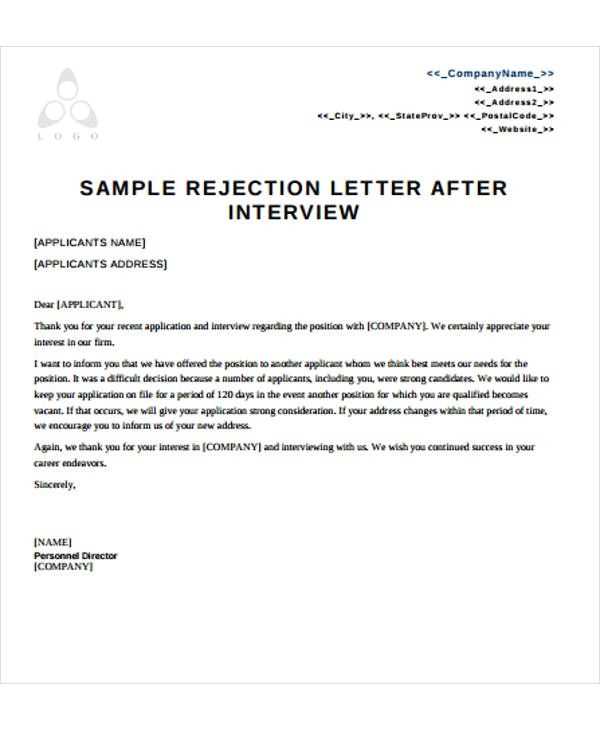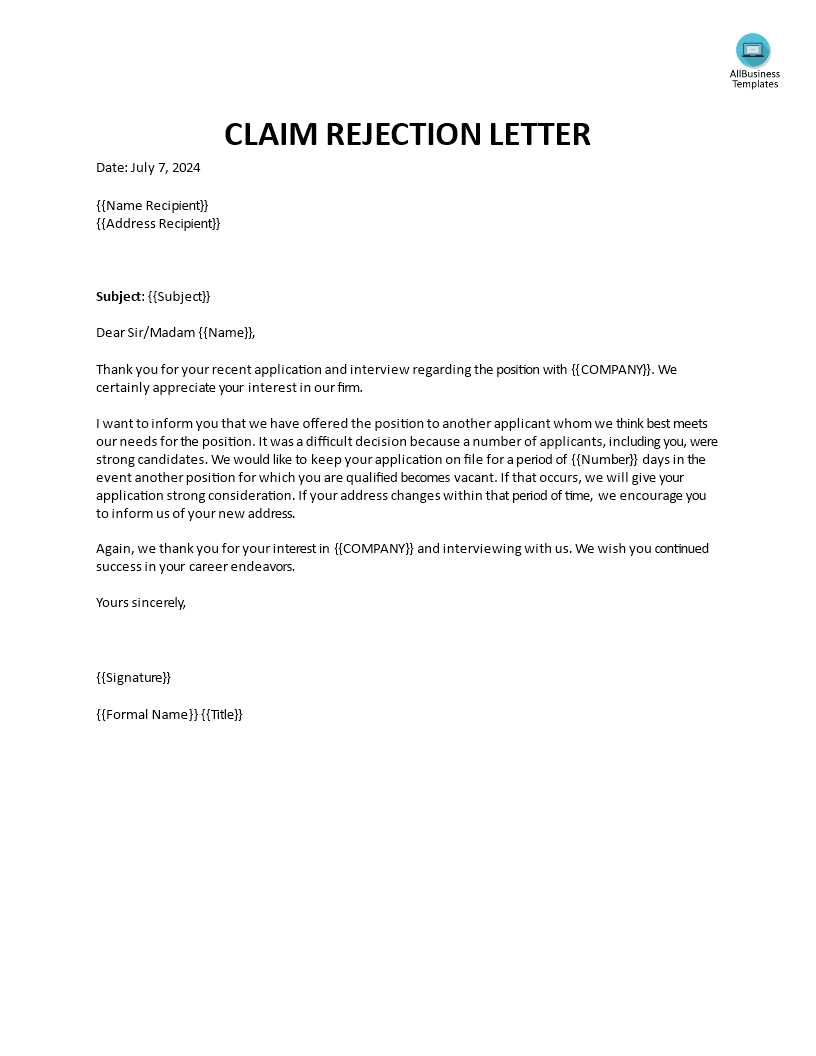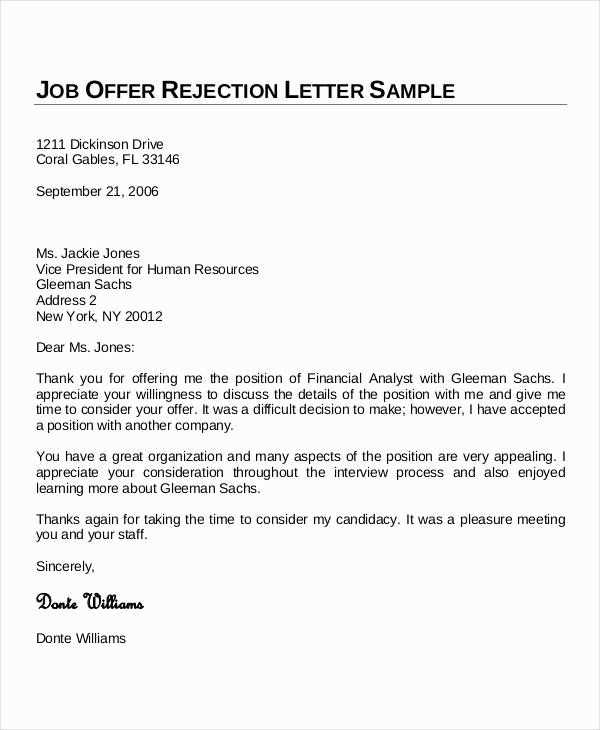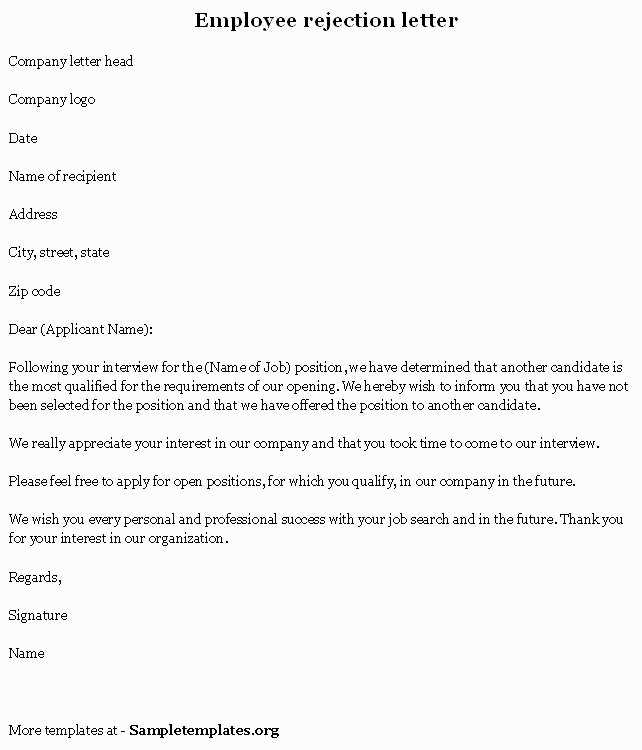Rejection letter templates

Clear and Direct Communication

Rejection letters must convey the message clearly, while maintaining a respectful tone. Use a straightforward approach that expresses your decision without ambiguity.
Template 1: Job Application Rejection
Subject: Job Application Outcome
Dear [Candidate Name],
Thank you for your application for the [Job Title] position at [Company Name]. After careful consideration, we regret to inform you that we have chosen to proceed with another candidate whose qualifications more closely match our needs.
We appreciate your interest in joining our team and wish you the best of luck in your future career endeavors.
Best regards,
[Your Name]
[Your Position]
[Company Name]
Template 2: Product Return Rejection
Subject: Return Request Status
Dear [Customer Name],
Thank you for contacting us regarding your request to return the [Product Name]. After reviewing your request, we are unable to accept the return due to [reason]. According to our policy, returns are only accepted under specific conditions, which unfortunately do not apply in this case.
We understand this may be disappointing and hope you understand our position. If you have any questions or concerns, feel free to reach out to us.
Sincerely,
[Your Name]
[Your Position]
[Company Name]
Template 3: Business Proposal Rejection
Subject: Business Proposal Response
Dear [Sender’s Name],
Thank you for submitting your proposal for [Proposal Title]. After reviewing it in detail, we have decided not to proceed with your offer at this time. We appreciate the effort and thoughtfulness behind your proposal, but we have chosen to move forward with another option that aligns better with our current objectives.
We value your interest in partnering with us and look forward to potential opportunities in the future.
Best regards,
[Your Name]
[Your Position]
[Company Name]
Template 4: Membership Rejection

Subject: Membership Application Status
Dear [Applicant Name],
Thank you for your interest in becoming a member of [Organization Name]. After careful review of your application, we regret to inform you that we are unable to offer you membership at this time.
We appreciate the time you spent applying and encourage you to apply again in the future should circumstances change.
Best regards,
[Your Name]
[Your Position]
[Organization Name]
Key Elements of a Rejection Letter

- Be brief and clear: State your decision early and avoid unnecessary elaboration.
- Be polite: Acknowledge the effort of the recipient and express appreciation.
- Offer closure: Let them know the process has been concluded, and no further action is required.
- Provide a reason (optional): If appropriate, briefly explain why the decision was made.
Final Thoughts
Rejection letters are an important part of communication in various contexts, and delivering them with respect and clarity can help preserve professional relationships. Use these templates as a guide to craft messages that are concise, polite, and effective in conveying your decision.
Rejection Letter Templates: A Comprehensive Guide
How to Write a Professional Job Rejection Letter
Best Practices for Crafting a Rejection Letter to a Candidate
Customizing Your Rejection Letter for Various Positions
When and How to Send a Rejection After an Interview
Handling Negative Responses to Your Rejection Letter
Legal Aspects to Consider When Writing a Job Rejection Letter
Keep your rejection letter concise and respectful. Start with a clear statement that the candidate was not selected. Acknowledge their effort and time, thanking them for applying. Avoid using overly negative or vague language. Let the candidate know you appreciate their interest and wish them success in the future.
When writing a rejection letter, aim for a professional yet compassionate tone. Highlight the positive qualities or skills the candidate demonstrated during the process, even if they weren’t chosen. This leaves a positive impression and ensures that the candidate feels valued, despite the outcome.
Customizing your rejection letter for various positions involves tailoring the message to reflect the specifics of the job or the interview process. For instance, if the role required technical skills, mention how the candidate’s qualifications were appreciated but another candidate better matched those technical needs. For managerial or creative roles, provide more personalized feedback on leadership or creative thinking. This helps the candidate understand why they were not selected without discouraging them.
Send your rejection letter soon after a decision is made to show respect for the candidate’s time. Ideally, this should be within a week after the interview. Delaying the response may lead to frustration or confusion. Consider sending an email as the quickest method, but a formal letter may be appropriate for higher-level positions.
Prepare for possible negative responses to your rejection letter. Candidates may ask for feedback or express disappointment. Respond politely and maintain professionalism. If you offer feedback, keep it constructive and clear, and avoid overly detailed critiques. It’s important to remain empathetic to their situation, as rejection can be tough for many applicants.
When crafting a rejection letter, be mindful of legal considerations. Avoid language that could be perceived as discriminatory or biased. Focus on the candidate’s qualifications relative to the position, and do not delve into personal attributes. Always comply with employment laws related to equal opportunity and anti-discrimination policies in your area.